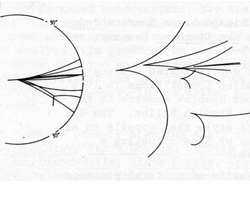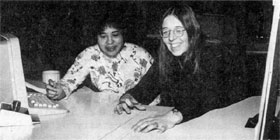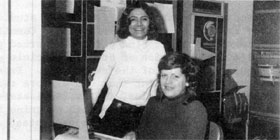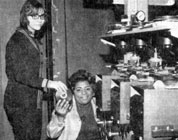Fermilab Scanners Uncover Secrets on Film
Glimpses of the unique regions of high energy physics explored in the Fermilab 15-Foot Bubble Chamber's first experimental runs are beginning to emerge from the Film Analysis Facility on the 9th floor of the Central Laboratory. In the hands of a group of twelve specially-skilled employees lie the clues to this vast reservoir of new knowledge. In their darkened headquarters, the scanners of the Film Analysis Facility combine their visual observations with electronic techniques to analyze film produced by the 15-Foot Chamber when two major experiments ran there, and the film of two experiments run in the 30" Bubble Chamber, in the latter half of 1974.
FAF's present scanning staff consists of Karen Carew, Steve Condon, Barbara Cox, Diana Dixon-Davis, Plane Garcia, Scott Meyer, Geri Palmer, Sue Poll, Beatrice Rohde, Annette Roy, Nancy Svejda, Georgia Sykes. Ray Hanft directs the work of the Scanning Group.
In the bubble chambers, each pulse of beam from the accelerator sends a shot of particles into the liquid hydrogen in the chamber. Cameras mounted in the top of the chambers photograph the interactions that occur as the beam passes through the hydrogen. About 10,000 pictures of the interactions are taken each good day of an experimental run in the 15-Foot Chamber, and nearly triple that number in the 30" Chamber. It is this film that is analyzed by the FAF.
One of the major experiments in the 15-Foot Chamber (Experiment 45, a collaboration of Fermilab, Soviet visitors, and the University of Michigan), captured the first neutrino-hydrogen interactions at Fermilab energies in which every charged track can be seen and recorded by the chamber's cameras. Another experiment (Experiment 234, a collaboration of Fermilab and Florida State experimenters) produced the first hadron exposure in the Fermilab 15-Foot Chamber, demonstrating the chamber as a tool for studying the strong interaction force. The two 30" Chamber exposures also being analyzed in FAF are a study of hadron-deuteron interactions (Experiment 194 - Fermilab, Stony Brook, Carnegie-Mellon University and the University of Michigan) and the first exposure of the 30" Chamber at Fermilab to an enriched anti-proton beam (Experiment 311 - Fermilab, Michigan State University, and Oxford University). In all experiments, the permanent unbiased filmed records of the experimental results have produced enough material for months and years of study.
The 15-Foot film is so rich and complex that no completely automated method can be devised to study it. The scanning procedure at Fermilab begins with the sharp observations of the scanners, as the film is run across a lighted table at the scanner's direction, magnified first at 12 times, then 66 times to examine fine details. A beginning scanner is provided a basic set of instructions - how to identify the interactions and then to record the location and a number of characteristics of the tracks. This is pure scanning, or reviewing, of the film, resembling the assembly of a library catalog of the film's contents. When the interactions have been identified, the scanner must measure the position of about ten points on each track, with a precision digitizing plane. These points are fed by the scanner into the PDP-9/L computer by tapping a foot-controlled device. Eventually, these points are analyzed by sophisticated PDP-10 programs to produce values for the momentum and direction of each track.
There is nothing in any other working community that prepares a scanner for this unusual work. It is precise work, but requires flexibility and good judgment. High energy particles are supposed to do this and that, scanners are told. But if they don't, decisions must be made quickly so that an unusual interaction or an apparent exception will be pointed out to experimenters. The diversity of the interactions is so large that even after a number of years of scanning, things will be seen that have never been seen before.
Annette Roy, Scanning Supervisor, points out that a lively pace has been set for the scanners with the influx of work to be done on the new film from the 15-Foot Chamber. "It makes our job more involved and more interesting," she says. "The 15-Foot film takes more time and requires more scanning."
Scanners' reports are studied by the scientists of the experiments. The film is shared by the institutions that collaborate in the experiment; observations are compared frequently.
Meanwhile, Fermilab scanners move from one to another of the scanning assignments at Fermilab's three MOMM's and four Micrometric tables. In this variation of their work, their individual abilities assure that the high points of the films will be captured and that monotony does not set in.
And what might emerge from these studies? According to Thornton Murphy, physicist currently serving as Chairman of the FAF Committee, an exciting possibility would be that Experiment 234 might find pairs of charmed particles. "If it doesn't," he says, " the detailed investigation of strange particle production at the highest energies in the world is a unique feature of the experiment. Experiment 45 is unique in that it is the one Fermilab neutrino experiment that can explore the full details of every charged track, and many of the neutral particles, in the final state of a neutrino interaction. And, naturally, they are looking for charm too - with neutrino interactions where there is a possibility of producing single charmed particles instead of pairs."
It will be the careful work of the FAF scanners that will have set up these observations for Fermilab experimenters.














